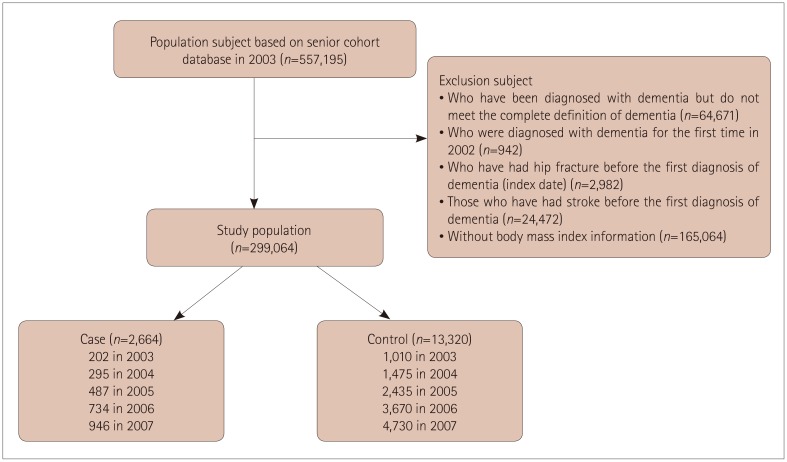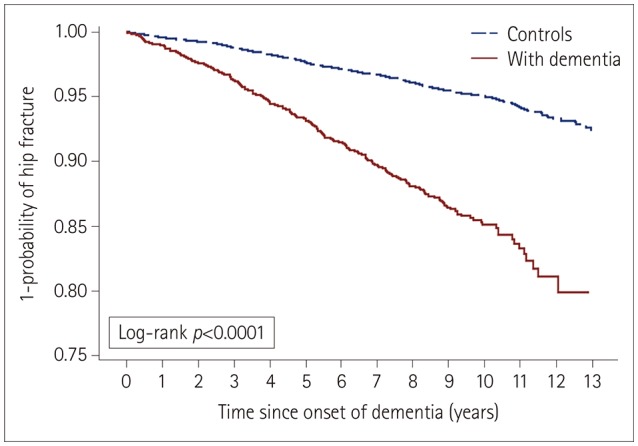J Clin Neurol.
2019 Apr;15(2):243-249. 10.3988/jcn.2019.15.2.243.
Dementia is Associated with an Increased Risk of Hip Fractures: A Nationwide Analysis in Korea
- Affiliations
-
- 1Department of Statistics, Kangwon National University, Chuncheon, Korea. ykim7stat@kangwon.ac.kr
- 2Department of Neurology, Kangwon National University School of Medicine, Kangwon National University Hospital, Chuncheon, Korea. light26@kangwon.ac.kr
- KMID: 2467739
- DOI: http://doi.org/10.3988/jcn.2019.15.2.243
Abstract
- BACKGROUND AND PURPOSE
Dementia has been reported to be associated with an increased risk of hip fracture, but few case-control studies have been performed to actually confirm this. This study investigated the association between dementia and hip fracture by comparing the risk of hip fracture between subjects with and without dementia.
METHODS
We examined a population-based matched cohort from the National Health Insurance Service-Senior Cohort data set that covers approximately half a million recipients of medical insurance in South Korea. Subjects with new clinically verified dementia during 2003-2007 were included, and five subjects without dementia were matched for age, sex, and index year to each subject with dementia as the controls. The risk of hip fracture for dementia was evaluated up to 2015 using Cox regression analysis.
RESULTS
During the 12-year follow-up period, 284 subjects with dementia (10.66%) and 603 subjects without dementia (4.53%) experienced hip fractures. Dementia was independently associated with a higher risk of hip fracture [hazard ratio (HR)=2.840, 95% CI=2.449-3.293] and the adjusted HR for hip fracture in the subjects with dementia was highest within 2 years after the initial diagnosis (HR=2.862, 95% CI=2.053-3.990).
CONCLUSIONS
This study found that dementia could be an independent risk factor for hip fracture even at the early stage. This necessitates consideration of the future risk of falls and balance deficits in terms of physical activity after a diagnosis of dementia.
MeSH Terms
Figure
Cited by 1 articles
-
Dementia and the Risk of Hip Fracture
Shih-Wei Lai
J Clin Neurol. 2020;16(1):157-157. doi: 10.3988/jcn.2020.16.1.157.
Reference
-
1. Friedman SM, Menzies IB, Bukata SV, Mendelson DA, Kates SL. Dementia and hip fractures: development of a pathogenic framework for understanding and studying risk. Geriatr Orthop Surg Rehabil. 2010; 1:52–62. PMID: 23569663.2. Ferri CP, Prince M, Brayne C, Brodaty H, Fratiglioni L, Ganguli M, et al. Global prevalence of dementia: a Delphi consensus study. Lancet. 2005; 366:2112–2117. PMID: 16360788.
Article3. Braithwaite RS, Col NF, Wong JB. Estimating hip fracture morbidity, mortality and costs. J Am Geriatr Soc. 2003; 51:364–370. PMID: 12588580.
Article4. Marks R. Hip fracture epidemiological trends, outcomes, and risk factors, 1970–2009. Int J Gen Med. 2010; 3:1–17. PMID: 20463818.5. Amboni M, Barone P, Hausdorff JM. Cognitive contributions to gait and falls: evidence and implications. Mov Disord. 2013; 28:1520–1533. PMID: 24132840.
Article6. Holmes J, House A. Psychiatric illness predicts poor outcome after surgery for hip fracture: a prospective cohort study. Psychol Med. 2000; 30:921–929. PMID: 11037100.
Article7. Baker NL, Cook MN, Arrighi HM, Bullock R. Hip fracture risk and subsequent mortality among Alzheimer's disease patients in the United Kingdom, 1988–2007. Age Ageing. 2011; 40:49–54. PMID: 21087990.
Article8. Tolppanen AM, Lavikainen P, Soininen H, Hartikainen S. Incident hip fractures among community dwelling persons with Alzheimer's disease in a Finnish nationwide register-based cohort. PLoS One. 2013; 8:e59124. PMID: 23527106.
Article9. Tolppanen AM, Taipale H, Tanskanen A, Tiihonen J, Hartikainen S. Comparison of predictors of hip fracture and mortality after hip fracture in community-dwellers with and without Alzheimer's disease - exposure-matched cohort study. BMC Geriatr. 2016; 16:204. PMID: 27908278.
Article10. Scandol JP, Toson B, Close JC. Fall-related hip fracture hospitalisations and the prevalence of dementia within older people in New South Wales, Australia: an analysis of linked data. Injury. 2013; 44:776–783. PMID: 23270698.
Article11. Lai SW, Chen YL, Lin CL, Liao KF. Alzheimer's disease correlates with greater risk of hip fracture in older people: a cohort in Taiwan. J Am Geriatr Soc. 2013; 61:1231–1232. PMID: 23855859.
Article12. Hebert LE, Scherr PA, Beckett LA, Albert MS, Pilgrim DM, Chown MJ, et al. Age-specific incidence of Alzheimer's disease in a community population. JAMA. 1995; 273:1354–1359. PMID: 7715060.
Article13. Farmer ME, Harris T, Madans JH, Wallace RB, Cornoni-Huntley J, White LR. Anthropometric indicators and hip fracture. The NHANES I epidemiologic follow-up study. J Am Geriatr Soc. 1989; 37:9–16. PMID: 2909610.14. Weller I, Schatzker J. Hip fractures and Alzheimer's disease in elderly institutionalized Canadians. Ann Epidemiol. 2004; 14:319–324. PMID: 15177270.
Article15. Johansson C, Skoog I. A population-based study on the association between dementia and hip fractures in 85-year olds. Aging (Milano). 1996; 8:189–196. PMID: 8862194.
Article16. Allan LM, Ballard CG, Rowan EN, Kenny RA. Incidence and prediction of falls in dementia: a prospective study in older people. PLoS One. 2009; 4:e5521. PMID: 19436724.
Article17. Anstey KJ, Von Sanden C, Luszcz MA. An 8-year prospective study of the relationship between cognitive performance and falling in very old adults. J Am Geriatr Soc. 2006; 54:1169–1176. PMID: 16913981.
Article18. Poehlman ET, Dvorak RV. Energy expenditure, energy intake, and weight loss in Alzheimer disease. Am J Clin Nutr. 2000; 71:650S–655S. PMID: 10681274.
Article19. De Laet C, Kanis JA, Odén A, Johanson H, Johnell O, Delmas P, et al. Body mass index as a predictor of fracture risk: a meta-analysis. Osteoporos Int. 2005; 16:1330–1338. PMID: 15928804.
Article20. Kripke DF, Langer RD, Kline LE. Hypnotics' association with mortality or cancer: a matched cohort study. BMJ Open. 2012; 2:e000850.
Article21. Rim TH, Kim DW, Han JS, Chung EJ. Retinal vein occlusion and the risk of stroke development: a 9-year nationwide population-based study. Ophthalmology. 2015; 122:1187–1194. PMID: 25726093.22. Anuurad E, Shiwaku K, Nogi A, Kitajima K, Enkhmaa B, Shimono K, et al. The new BMI criteria for asians by the regional office for the western pacific region of WHO are suitable for screening of overweight to prevent metabolic syndrome in elder Japanese workers. J Occup Health. 2003; 45:335–343. PMID: 14676412.
Article23. Faxén-Irving G, Fereshtehnejad SM, Falahati F, Cedergren L, Göranzon H, Wallman K, et al. Body mass index in different dementia disorders: results from the Swedish dementia quality registry (SveDem). Dement Geriatr Cogn Dis Extra. 2014; 4:65–75. PMID: 24847345.24. Olde Rikkert MG, Verhey FR, Sijben JW, Bouwman FH, Dautzenberg PL, Lansink M, et al. Differences in nutritional status between very mild Alzheimer's disease patients and healthy controls. J Alzheimers Dis. 2014; 41:261–271. PMID: 24614903.
Article25. Droogsma E, Van Asselt DZ, Schölzel-Dorenbos CJ, Van Steijn JH, Van Walderveen PE, Van der Hooft CS. Nutritional status of community-dwelling elderly with newly diagnosed Alzheimer's disease: prevalence of malnutrition and the relation of various factors to nutritional status. J Nutr Health Aging. 2013; 17:606–610. PMID: 23933871.
Article26. Van der Flier WM, Scheltens P. Epidemiology and risk factors of dementia. J Neurol Neurosurg Psychiatry. 2005; 76(Suppl 5):v2–v7. PMID: 16291918.
Article27. Gorelick PB. Risk factors for vascular dementia and Alzheimer disease. Stroke. 2004; 35(11 Suppl 1):2620–2622. PMID: 15375299.
Article28. Nordström P, Franks PW, Gustafson Y, Nordström A. Cognitive function in young men and the later risk of fractures. J Bone Miner Res. 2012; 27:2291–2297. PMID: 22692934.
Article29. Wang HK, Hung CM, Lin SH, Tai YC, Lu K, Liliang PC, et al. Increased risk of hip fractures in patients with dementia: a nationwide population-based study. BMC Neurol. 2014; 14:175. PMID: 25213690.
Article30. Zhao Y, Shen L, Ji HF. Alzheimer's disease and risk of hip fracture: a meta-analysis study. ScientificWorldJournal. 2012; 2012:872173. PMID: 22629218.
Article31. Bukata SV, Kates SL, O'Keefe RJ. Short-term and long-term orthopaedic issues in patients with fragility fractures. Clin Orthop Relat Res. 2011; 469:2225–2236. PMID: 21279487.
Article32. Gras LZ, Kanaan SF, McDowd JM, Colgrove YM, Burns J, Pohl PS. Balance and gait of adults with very mild Alzheimer disease. J Geriatr Phys Ther. 2015; 38:1–7. PMID: 24755691.
Article33. Guo Z, Wills P, Viitanen M, Fastbom J, Winblad B. Cognitive impairment, drug use, and the risk of hip fracture in persons over 75 years old: a community-based prospective study. Am J Epidemiol. 1998; 148:887–892. PMID: 9801019.
Article34. Pettersson AF, Olsson E, Wahlund LO. Motor function in subjects with mild cognitive impairment and early Alzheimer's disease. Dement Geriatr Cogn Disord. 2005; 19:299–304. PMID: 15785030.
Article35. Yan JH, Dick MB. Practice effects on motor control in healthy seniors and patients with mild cognitive impairment and Alzheimer's disease. Neuropsychol Dev Cogn B Aging Neuropsychol Cogn. 2006; 13:385–410. PMID: 16887780.
Article36. Duggan S, Blackman T, Martyr A, Van Schaik P. The impact of early dementia on outdoor life: a ‘shrinking world’? Dementia. 2008; 7:191–204.37. Paterniti S, Verdier-Taillefer MH, Dufouil C, Alpérovitch A. Depressive symptoms and cognitive decline in elderly people. Longitudinal study. Br J Psychiatry. 2002; 181:406–410. PMID: 12411266.38. Wilkins CH, Roe CM, Morris JC, Galvin JE. Mild physical impairment predicts future diagnosis of dementia of the Alzheimer's type. J Am Geriatr Soc. 2013; 61:1055–1059. PMID: 23647233.
Article39. Tolea MI, Morris JC, Galvin JE. Longitudinal associations between physical and cognitive performance among community-dwelling older adults. PLoS One. 2015; 10:e0122878. PMID: 25875165.
Article40. Gleason LJ, Menzies IB, Mendelson DA, Kates SL, Friedman SM. Diagnosis and treatment of osteoporosis in high-risk patients prior to hip fracture. Geriatr Orthop Surg Rehabil. 2012; 3:79–83. PMID: 23569701.
Article41. Norring-Agerskov D, Laulund AS, Lauritzen JB, Duus BR, Van der Mark S, Mosfeldt M, et al. Metaanalysis of risk factors for mortality in patients with hip fracture. Dan Med J. 2013; 60:A4675. PMID: 23905564.
- Full Text Links
- Actions
-
Cited
- CITED
-
- Close
- Share
- Similar articles
-
- Analysis of Missed Fractures by Bone Scan in Elderly Hip Fracture Patients with Osteoporosis
- Risk of Hip Fractures in Men with Alpha-Blockers: A Nationwide Study Base on Claim Registry
- Efficacy of the Preventive Abduction Brace in Dementia Patients After Bipolar hemiarthroplasty of the Hip
- Differential Impact of Cigarette Smoking on Fracture Risks in Subjective Cognitive Decline and Dementia: A Nationwide Longitudinal Study
- The incidence of hip fracture and mortality rate after hip fracture in Korea: A nationwide population-based cohort study



